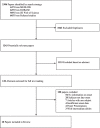What do we know about Late Onset Huntington's Disease?
- PMID: 28671137
- PMCID: PMC5502838
- DOI: 10.3233/JHD-170247
What do we know about Late Onset Huntington's Disease?
Abstract
Background: Although the typical age of onset for Huntington's disease (HD) is in the fourth decade, between 4.4-11.5% of individuals with HD have a late onset (over 60 years of age). Diagnosis of Late onset HD (LoHD) can be missed, due to the perceived low likelihood of HD in the over 60-year-olds.
Objective: To review the epidemiology, genotype and phenotype of LoHD.
Methods: We systematically searched MEDLINE, EMBASE and Web of Science (inception-November 2016). Web of Science was then used to search for papers citing identified studies. Content experts were consulted for any additional studies. We included all studies reporting the clinical phenotype of LoHD for more than one participant.
Results: 20 studies were identified from a potential list of 1243. Among Caucasian HD cohorts, 4.4-11.5% of individuals have LoHD, and this proportion may be increasing. Proportion of LoHD without a positive family history ranges from 3-68%. 94.4% of reported cases of LoHD had CAG repeat lengths of ≤44. Motor manifestations are the commonest initial presentation, although 29.2% presented with non-motor manifestations as the first clinical feature in one case series. Individuals with LoHD may have slower progression of illness. Cognitive impairment rather than chorea may be the major source of disability in this group.
Conclusions: LoHD represents a substantial proportion of new diagnoses of HD and has some unique features. Further characterization of this population will aid clinicians in diagnosis.
Keywords: Huntington’s disease; aged; late onset Huntington’s disease; trinucleotide repeat expansion.
References
-
- The Huntington’s Disease Collaborative Research Group. A novel gene containing a trinucleotide repeat that is expanded and unstable on Huntington’s disease chromosomes. Cell. 1993;72(6):971–83. - PubMed
-
- Gómez-Tortosa E, del Barrio A, Ruiz PJG, Pernaute RS, Benítez J, Barroso A, et al. Severity of cognitive impairment in juvenile and late-onset Huntington disease. Arch Neurol. 1998;55(6):835–43. - PubMed
Publication types
MeSH terms
LinkOut - more resources
Full Text Sources
Other Literature Sources
Medical


